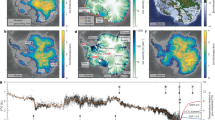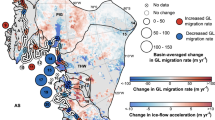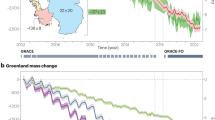Abstract
During ice-age glacial maxima of the last ∼2.6 million years, ice sheets covered large portions of the Northern Hemisphere. Records from the retreat of these ice sheets during deglaciations provide important insights into how ice sheets behave under a warming climate. During the last two deglaciations, the southernmost margins of land-based Northern Hemisphere ice sheets responded nearly instantaneously to warming caused by increased summertime solar energy reaching the Earth. Land-based ice sheets subsequently retreated at a rate commensurate with deglacial climate warming. By contrast, marine-based ice sheets experienced a delayed onset of retreat relative to warming from increased summertime solar energy, with retreat characterized by periods of rapid collapse. Both observations raise concern over the response of Earth's remaining ice sheets to carbon-dioxide-induced global warming. The almost immediate reaction of land-based ice margins to past small increases in summertime energy implies that the Greenland Ice Sheet could be poised to respond to continuing climate change. Furthermore, the prehistoric precedent of marine-based ice sheets undergoing abrupt collapses raises the potential for a less predictable response of the marine-based West Antarctic Ice Sheet to future climate change.
This is a preview of subscription content, access via your institution
Access options
Subscribe to this journal
Receive 12 print issues and online access
$259.00 per year
only $21.58 per issue
Buy this article
- Purchase on Springer Link
- Instant access to full article PDF
Prices may be subject to local taxes which are calculated during checkout






Similar content being viewed by others
References
Broecker, W. S. & van Donk, J. Insolation changes, ice volumes, and the O18 record in deep-sea cores. Rev. Geophys. Space Phys. 8, 169–198 (1970).
Imbrie, J. et al. On the structure and origin of major glaciation cycles 2: The 100,000-year cycle. Paleoceanography 8, 699–735 (1993).
Shakun, J. D. & Carlson, A. E. A global perspective on Last Glacial Maximum to Holocene climate change. Quat. Sci. Rev. 29, 1801–1816 (2010).
Clark, P. U. et al. Global climate evolution during the last deglaciation. Proc. Natl Acad. Sci. USA 109, E1134–E1142 (2012).
Dyke, A. S. in Quaternary Glaciations: Extent and Chronology Vol. 2 (eds Ehlers, J. & Gibbard, P. L.) 373–424 (Elsevier, 2004).
Svendsen, J.-I. et al. Late Quaternary ice sheet history of northern Eurasia. Quat. Sci. Rev. 23, 1229–1271 (2004).
Hays, J. D., Imbrie, J. & Shackleton, N. J. Variations in the Earth's Orbit: Pacemaker of the Ice Ages. Science 194, 1121–1132 (1976).
Weertman, J. Milankovitch solar radiation variations and ice age ice sheet sizes. Nature 261, 17–20 (1976).
Berger, A. & Loutre, M. F. Insolation values for the climate of the last 10 million years. Quat. Sci. Rev. 10, 297–317 (1991).
CAPE-Last Interglacial Project Members. Last Interglacial Arctic warmth confirms polar amplification of climate change. Quat. Sci. Rev. 25, 1383–1400 (2006).
Roe, G. In defense of Milankovitch. Geophys. Res. Lett. 33, L24703 (2006).
Jouzel, J. et al. Orbital and millennial antarctic climate variability over the past 800,000 years. Science 317, 793–796 (2007).
Huybers, P. & Denton, G. Antarctic temperature at orbital timescales controlled by local summer duration. Nature Geosci. 1, 787–792 (2008).
Cheng, H. et al. Ice age terminations. Science 326, 248–252 (2009).
Clark, P. U. et al. The Last Glacial Maximum. Science 325, 710–714 (2009).
Milne, G. A., Mitrovica, J. X. Searching for eustasy in deglacial sea-level histories. Quat. Sci. Rev. 27, 2292–2302 (2008).
Thomas, A. L. et al. Penultimate deglacial sea-Level timing from uranium/thorium dating of Tahitian corals. Science 324, 1186–1189 (2009).
Kopp, R. E. et al. Probabilistic assessment of sea level during the last interglacial stage. Nature 462, 863–867 (2009).
Overpeck, J. T. et al. Paleoclimatic evidence for future ice-sheet instability and rapid sea-level rise. Science 311, 1747–1750 (2006).
Thompson, W. G. & Goldstein, S. L. Open-system coral ages reveal persistent suborbital sea-level cycles. Science 308, 401–404 (2005).
Siddall, M., Bard, E., Rohling, E. J. & Hemleben, C. Sea-level reversal during Termination II. Geology 34, 817–820 (2006).
Wood, J. R., Forman, S. L., Pierson, J. & Gomez, J. New insights on Illinoian deglaciation from deposits of Glacial Lake Quincy, central Indiana. Quat. Res. 73, 374–384 (2010).
Larsen, N. K. et al., Late Quaternary ice sheet, lake and sea history of southwest Scandinavia — a synthesis. Boreas 38, 732–761 (2009).
Green, C. L., Bigg, G. R. & Green, J. A. M. Deep draft icebergs from the Barents Ice Sheet during MIS 6 are consistent with erosional evidence from the Lomonosov Ridge, central Arctic. Geophys. Res. Lett. 37, L23606 (2010).
Stanford, J. D. et al. A new concept for the paleoceanographic evolution of Heinrich event 1 in the North Atlantic. Quat. Sci. Rev. 30, 1047–1066 (2011).
Licciardi, J. M., Teller, J. T. & Clark, P. U. in Mechanisms of Global Climate Change at Millennial Time Scales (eds Clark, P. U., Webb, R. S. & Keigwin, L. D.) 177–201 (AGU, 1999).
Carlson, A. E. Why there was not a Younger Dryas-like event during the Penultimate Deglaciation. Quat. Sci. Rev. 27, 882–887 (2008).
Stoner, J. S., Channell, J. E. T. & Hillaire-Marcel, C. Magnetic properties of deep-sea sediments off southwest Greenland: Evidence for major differences between the last two deglaciations. Geology 23, 241–244 (1995).
Carlson, A. E., Stoner, J. S., Donnelly, J. P. & Hillaire-Marcel, C. Response of the southern Greenland Ice Sheet during the last two deglaciations. Geology 36, 359–362 (2008).
Colville, E. J. et al. Sr-Nd-Pb isotope evidence for ice-sheet presence on southern Greenland during the last interglacial. Science 333, 620–623 (2011).
Tarasov, L. & Peltier, W. R. Greenland glacial history, borehole constraints, and Eemian extent. J. Geophys. Res. 108, 2143 (2003).
Cuffey, K. M. & Marshall, S. J. Substantial contribution to sea-level rise during the last interglacial from the Greenland ice sheet. Nature 404, 591–594 (2000).
Lhomme, N., Clarke, G. K. C. & Marshall, S. J. Tracer transport in the Greenland Ice Sheet: constraints on ice cores and glacial history. Quat. Sci. Rev. 24, 173–194 (2005).
Otto-Bliesner, B. L. et al. Simulating Arctic climate warmth and icefield retreat in the last interglaciation. Science 311, 1751–1753 (2006).
Robinson, A., Calov, R. & Ganopolski, A. Greenland ice sheet model parameters constrained using simulations of the Eemian Interglacial. Clim. Past 7, 381–396 (2011).
Hemming, S. R. Heinrich events: massive late Pleistocene detritus layers of the North Atlantic and their global climate imprint. Rev. Geophys. 42, RG1005 (2004).
Yokoyama, Y., Lambeck, K., De Deckker, P., Johnston, P. & Fifield, L. K. Timing of the Last Glacial Maximum from observed sea-level minima. Nature 406, 713–716 (2000).
Peltier, W. R. Global glacial isostacy and the surface of the ice-age Earth: The ICE-5G (VM2) model and GRACE. Annu. Rev. Earth Planet. Sci. 32, 111–149 (2004).
Hanebuth, T. J. J., Stattegger, K. & Bojanowski, A. Termination of the Last Glacial Maximum sea-level lowstand: The Sunda-Shelf data revisited. Global Planet. Change 66, 76–84 (2009).
Clark, P. U., McCabe, A. M., Mix, A. C. & Weaver, A. J. Rapid rise of sea level 19,000 years ago and its global implications. Science 304, 1141–1144 (2004).
PALSEA Members. The sea-level conundrum: case studies from palaeo-archives. J. Quat. Sci. 25, 19–25 (2009).
Deschamps, P. et al. Ice-sheet collapse and sea-level rise at the Bølling warming 14,600 years ago. Nature 483, 559–564 (2012).
Hansel, A. K. & Johnson, W. H. Fluctuations of the Lake Michigan lobe during the late Wisconsin subepisode. Geolog. Surv. Sweden 81, 133–144 (1992).
Curry, B. B. et al. The DeKalb mounds of northeastern Illinois as archives of deglacial history and postglacial environments. Quat. Res. 74, 82–90 (2010).
Curry, B. & Petras, J. Chronological framework for the deglaciation of the Lake Michigan lobe of the Laurentide Ice Sheet from ice-walled lake deposits. J. Quat. Sci. 26, 402–410 (2011).
Mickelson, D. M., Clayton, L., Fullerton, D. S. & Borns, H. W. in Late-Quaternary Environments of the United States Vol. 1 (ed. Wright, H. E.) 3–37 (1983).
Glover, K. C. et al. Deglaciation, basin formation and post-glacial climate change from a regional network of sediment core sites in Ohio and eastern Indiana. Quat. Res. 76, 401–410 (2011).
Bettis, E. A., Jr., Quade, D. J. & Kemmis, T. J. Hogs, bogs, and logs: Quaternary deposits and environmental geology of the Des Moines Lobe. Geol. Surv. Bureau Guidebook 18, 1–170 (1996).
Balco, G., Stone, J. O. H., Porter, S. C. & Caffee, M. W. Cosmogenic-nuclide ages for New England coastal moraines, Martha's Vineyard and Cape Cod, Massachusetts, USA. Quat. Sci. Rev. 21, 2127–2135 (2002).
Balco, G. et al. Regional beryllium-10 production rate calibration for late-glacial northeastern North America. Quat. Geochronol. 4, 93–107 (2009).
Leventer, A., Williams, D. F. & Kennett, J. P. Dynamics of the Laurentide ice sheet during the last deglaciation: evidence from the Gulf of Mexico. Earth Planet. Sci. Lett. 59, 11–17 (1982).
Rinterknecht, V. R. et al. The last deglaciation of the southeastern sector of the Scandinavian Ice Sheet. Science 311, 1449–1452 (2006).
Goehring, B. M. et al. Late Glacial and Holocene 10Be production rates for western Norway. J. Quat. Sci. 27, 89–96 (2012).
McCabe, A. M., Clark, P. U. & Clark, J. AMS 14C dating of deglacial events in the Irish Sea Basin and other sectors of the British-Irish ice sheet. Quat. Sci. Rev. 24, 1673–1690 (2005).
Clark, J. et al.10Be chronology of the last deglaciation of County Donegal, northwestern Ireland. Boreas 38, 111–118 (2009).
Ballantyne, C. K. Extent and deglacial chronology of the last British-Irish Ice Sheet: implications of exposure dating using cosmogenic isotopes. J. Quat. Sci. 25, 515–534 (2010).
Ballantyne, C. K. & Stone, J. O. Did large ice caps persist on low ground in north-west Scotland during the Lateglacial Interstade? J. Quat. Sci. 27, 297–306 (2012).
Clark, J. et al. Response of the Irish Ice Sheet to abrupt climate change during the last deglaciation. Quat. Sci. Rev. 35, 100–115 (2012).
Clark, C. D., Hughes, A. L. C., Greenwood, S. L., Jordan, C. & Sejrup, H. P. Pattern and timing of retreat of the last British-Irish Ice Sheet. Quat. Sci. Rev. 44, 112–146 (2012).
Menot, G. et al. Early reactivation of European rivers during the last deglaciation. Science 313, 1623–1625 (2006).
Dyke, A. S. & Prest, V. K. Late Wisconsinan and Holocene history of the Laurentide Ice Sheet. Geogr. Phys. Quatern. 41, 237–263 (1987).
Pollard, D. & Thompson, S. L. Climate and ice-sheet mass balance at the Last Glacial Maximum from the GENESIS Version 2 global climate model. Quat. Sci Rev. 16, 841–863 (1997).
Landvik, J. Y. et al. The Last Glacial Maximum of Svalbard and the Barents Sea area: ice sheet extent and configuration. Quat. Sci. Rev. 17, 43–75 (1998).
Vogt, C., Knies, J., Spielhagen, R. F. & Stein, R. Detailed mineralogical evidence for two nearly identical glacial/deglacial cycles and Atlantic water advection to the Arctic Ocean during the last 90,000 years. Glob. Planet. Change 31, 23–44 (2001).
Rasmussen, T. L. et al. Paleoceanographic evolution of the SW Svalbard margin (76 °N) since 20,000 14C yr BP. Quat. Res. 67, 100–114 (2007).
Jessen, S. P., Rasmussen, T. L., Nielsen, T. & Solheim, A. A new late Weichselian and Holocene marine chronology for the western Svalbard slope 30, 000–0 cal years BP. Quat. Sci. Rev. 29, 1301–1312 (2010).
Jones, G. A. & Keigwin, L. D. Evidence from Fram Strait (78° N) for early deglaciation. Nature 336, 56–59 (1988).
Koç, N. & Jansen, E. Response of the high-latitude Northern Hemisphere to orbital climate forcing: Evidence from the Nordic Seas. Geology 22, 523–526 (1994).
Nam, S. I., Stein, R., Grobe, H. & Hubberten, H. Late Quaternary glacial-interglacial changes in sediment composition at the East Greenland continental margin and their paleoceanographic implications. Mar. Geol. 122, 243–262 (1995).
Andrews, J. T., Smith, L. M., Preston, R., Cooper, T. & Jennings, A. E. Spatial and temporal patterns of iceberg rafting (IRD) along the East Greenland margin, ca. 68° N, over the last 14 cal.ka. J. Quat. Sci. 12, 1–13 (1997).
Håkansson, L., Briner, J., Alexanderson, H., Aldahan, A. & Possnert, G. 10Be ages from central east Greenland constrain the extent of the Greenland ice sheet during the Last Glacial Maximum. Quat. Sci. Rev. 26, 2316–2321, (2007).
Rinterknecht, V., Gorokhovich, Y., Schaefer, J. & Caffee, M. Preliminary 10Be chronology for the last deglaciation of the western margin of the Greenland Ice Sheet. J. Quat. Sci. 24, 270–278 (2008).
Marcott, S. A. et al. Ice-shelf collapse from subsurface warming as a trigger for Heinrich events. Proc. Natl Acad. Sci. USA 108, 13415–13419 (2011).
Barber, D. C. et al. Forcing of the cold event of 8,200 years ago by catastrophic drainage of Laurentide lakes. Nature 400, 344–348 (1999).
Li, Y.-X., Törnqvist, T. E., Nevitt, J. A. & Kohl, B. Synchronizing a sea-level jump, final Lake Agassiz drainage, and abrupt cooling 8200 years ago. Earth Planet. Sci. Lett. 315–316, 41–50 (2012).
Jennings, A. E., Hald, M., Smith, M. & Andrews, J. T. Freshwater forcing from the Greenland Ice Sheet during the Younger Dryas: evidence from southeastern Greenland shelf cores. Quat. Sci. Rev. 25, 282–298 (2006).
Bennike, O. & Björck, S. Chronology of the last recession of the Greenland Ice Sheet. J. Quat. Sci. 17, 211–219 (2002).
Roberts, D. H., Long, A. J., Schnabel, C., Freeman, S. & Simpson, M. J. R. The deglacial history of southeast sector of the Greenland Ice Sheet during the Last Glacial Maximum. Quat. Sci. Rev. 27, 1505–1516 (2008).
Roberts, D. H. et al. Ice sheet extent and early deglacial history of the southwestern sector of the Greenland Ice Sheet. Quat. Sci. Rev. 28, 2760–2773 (2009).
Simpson, M. J. R., Milne, G. A., Huybrechts, P. & Long, A. J. Calibrating a glaciological model of the Greenland ice sheet from the Last Glacial Maximum to present-day using field observations of relative sea level and ice extent. Quat. Sci. Rev. 28, 1631–1657 (2009).
Young, N. E. et al. Response of Jakobshavn Isbræ, Greenland, to Holocene climate change. Geology 39, 131–134 (2011).
Ruddiman, W. F., Molfino, B., Esmay, A. & Pokras, E. Evidence bearing on the mechanism of rapid deglaciation. Climatic Change 3, 65–87 (1980).
Dutton, A. et al. Phasing and amplitude of sea-level and climate change during the penultimate interglacial. Nature Geosci. 2, 355–359 (2009).
Rohling, E. J. et al. Antarctic temperature and global sea level closely coupled over the past five glacial cycles. Nature Geosci. 2, 500–504 (2009).
Andersen, M. B. et al. High-precisions U-series measurements of more than 500,000 year old fossil corals. Earth Planet. Sci. Lett. 265, 229–245 (2008).
Raymo, M. E., Mitrovica, J. X. Collapse of polar ice sheets during the stage 11 interglacial. Nature 483, 453–456 (2012).
Joyce, J. E., Tjalsma, L. R. C. & Prutzman, J. M. North American glacial meltwater history for the past 2.3 m.y.: Oxygen isotope evidence from the Gulf of Mexico. Geology 21, 483–486 (1993).
Hodell, D. A., Channell, J. E. T., Curtis, J. H., Romero, O. E. & Röhl, U. Onset of “Hudson Strait” Heinrich events in the eastern North Atlantic at the end of the middle Pleistocene transition (∼640 ka)? Paleoceanography 23, PA4218 (2008).
de Vernal, A. & Hillaire-Marcel, C. Natural variability of Greenland climate, vegetation, and ice volume during the past million years. Science 320, 1622–1625 (2008).
Channell, J. E. T., Xuan, C. & Hodell, D. A. Stacking paleointensity and oxygen isotope data for the last 1.5 Myr (PISO-1500). Earth Planet. Sci. Lett. 283, 14–23 (2009).
Rahmstorf, S. A semi-empirical approach to projecting future sea-level rise. Science 315, 368–370 (2007).
Siddall, M. et al. Changing influence of Antarctic and Greenlandic temperature records on sea-level over the last glacial cycle. Quat. Sci. Rev. 29, 410–423 (2010).
Pollard, D. & DeConto, R. M. Modelling West Antarctic ice sheet growth and collapse through the past five million years. Nature 458, 329–332 (2009).
Tarasov, L., Dyke, A. S., Neal, R. M. & Peltier, W. R. A data-calibrated distribution of deglacial chronologies for the North American ice complex from glaciological modeling. Earth Planet. Sci. Lett. 315–316, 30–40 (2012).
Siddall, M. & Kaplan, M. R. A tale of two ice sheets. Nature Geosci. 1, 570–571 (2008).
Alley, R. B., Clark, P. U., Huybrechts, P. & Joughin, I. Ice-sheet and sea-level changes. Science 310, 456–460 (2005).
Mercer, J. H. West Antarctic ice sheet and CO2 greenhouse effect: a threat of disaster. Nature 271, 321–325 (1978).
Meehl, G. A. et al. in Climate Change 2007: The Physical Science Basis. Contribution of Working Group I to the Fourth Assessment Report of the IPCC (eds Solomon, S. et al.) (Cambridge Univ. Press, 2007).
Acknowledgements
The authors wish to thank F. Anslow, S. Marcott, S. Peters, and J. Shakun for their insightful comments on this manuscript, R. Kopp for providing his sea-level record, and R. Gyllencreutz, J. Mangerud, J.-I. Svendsen and Ø Lohne for sharing their compilation of Eurasian ice-sheet margin chronologies. PALSEA, a PAGES/WUN working group, was instrumental in forming the ideas presented here. A.E.C. and K.W. are supported by the National Science Foundation Paleoclimate and Graduate Research Fellowship Programs, respectively.
Author information
Authors and Affiliations
Corresponding author
Ethics declarations
Competing interests
The authors declare no competing financial interests.
Rights and permissions
About this article
Cite this article
Carlson, A., Winsor, K. Northern Hemisphere ice-sheet responses to past climate warming. Nature Geosci 5, 607–613 (2012). https://doi.org/10.1038/ngeo1528
Received:
Accepted:
Published:
Issue Date:
DOI: https://doi.org/10.1038/ngeo1528
This article is cited by
-
StableClim, continuous projections of climate stability from 21000 BP to 2100 CE at multiple spatial scales
Scientific Data (2020)
-
Role of Asian summer monsoon subsystems in the inter-hemispheric progression of deglaciation
Nature Geoscience (2019)
-
Enhanced climate instability in the North Atlantic and southern Europe during the Last Interglacial
Nature Communications (2018)
-
Forcing of late Pleistocene ice volume by spatially variable summer energy
Scientific Reports (2018)
-
Lack of evidence for a substantial sea-level fluctuation within the Last Interglacial
Nature Geoscience (2018)



